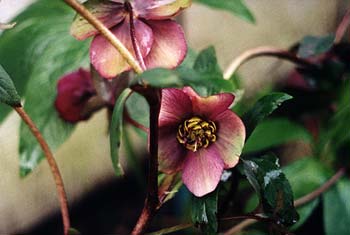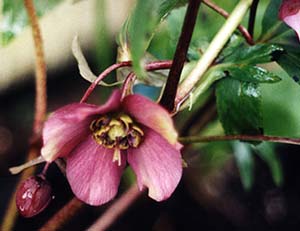 'Rose Madder' Hellebore
'Rose Madder' Hellebore
"Winter under cultivation
Is as arable as Spring."
-Emily Dickinson,
1830‚1886
1830‚1886
This hybrid Hellebore is named Heronswood Rose Madder, developed at Heronswood nursery which is nationally famous for introducing new varieties. The portrait is from late March, when it had already been blooming some weeks; if I replaced this photo with one from April it would have many more large leaves & still producing vibrant flowers.
Though generally regarded as a shade plant, Heronswood suggests for the Puget Sound region they be permitted rather more sun than folks elsewhere assume they need. Other hellebores I'd already planted deeper into the shade-corridor did not grow so huge & bushy nearly so rapidly as the Rose Madder & the Heronswood Yellow varieties that are placed at the sunnier head of the corridor. So I was able to compare just how right Heronswoods' owner was on that score. Though I should note how in the long run even the hellebore in the deepest shade became a big impressive bloomer; it merely took longer.
 I'm only a moderate hellebore fan; they appeal too much to overlook altogether, but they take more care than I prefer. Their minuses for me are that I'm much more of a "woody shrub" fan & like that if a dog or cat goes barrelling through a flower bed, they can't cause any harm to woody shrubs, nor can slugs & snails ruin the look of shrubs or even the hardy groundcovers. But a hellebore's fragile flower stalks can be too easily broken by a clumsy animal, or even a hard rainfall, not to mention that when flowers sag toward the ground, slugs can reach them.
I'm only a moderate hellebore fan; they appeal too much to overlook altogether, but they take more care than I prefer. Their minuses for me are that I'm much more of a "woody shrub" fan & like that if a dog or cat goes barrelling through a flower bed, they can't cause any harm to woody shrubs, nor can slugs & snails ruin the look of shrubs or even the hardy groundcovers. But a hellebore's fragile flower stalks can be too easily broken by a clumsy animal, or even a hard rainfall, not to mention that when flowers sag toward the ground, slugs can reach them. Plus, our soils are naturally acidic & perfect for so many rainy-weather plants, but hellebores prefer a slightly alkaline or at least neutral pH soil. When I attended a Heronswood lecture on hellebore care, they suggested a method of amending acidic soil to be ideal for hellebores but which would not alter the soil for other plants growing nearby: Once a year, insert a piece of white blackboard chalk into the rootsystem of each hellebore, where it will serve as a slow-release alkalinizer right there in that one plant's roots. I have found that advice useful for the few other plants in our gardens, such as the hart's-tongue fern which is one of the few ferns that prefers the alkaline side of the pH scale.
But, well, hellebores are hardy under a wide variety of soils, & people who just put them in whatever soil they have, even if it's acid pH, the hellebores will do all right.
What I like about hellebores, besides the remarkable flowers, is the evergreen nature of the large leaves. Well, to some extent they are only semi-evergreen, as it is best to remove the old leaves when young ones began to appear at the start of each new year, but they can be left on the plant in the meantime.
Through much of the winter, the hellebore's umbrella-like leaves look great among such winter-hardy plants as Japanese Tassell Ferns or black mondo grass & other low-growing moisture-loving evergreens. I've experimented in different years & on different clumps with how long to keep the leaves, which at some point need to be remove them, no matter how nice they still seem to be. If left intact until February's end or early March, the flowers will be hidden until eventually reaching well above the old leaves to be seen together with the leaves. But if taken off by late January or early February, new leaves will be far enough behind the flowers that for a while the flowers dangle there almost with only a few diminuative leaves, lacking a "full clump" appearance.
I used to think the flowers looked best with the previous year's leaves intact, & would not cut the old leaves back until new ones were well along or the previous year's foliage was getting worn looking. But presently I like to clear the view so I can watch as the first flower-buds & leaves appear at mid-January, much as I also love seeing the emerging "horns" of hostas or jack-in-the-pulpits. It's ultimately a matter of personal choice & decision, as the clump does not appear short of energy if the old leaves are left well into spring, but neither is new growth speedier if the old leaves are taken off earlier. So presently I take off the old leaves before January's end, but in future years if I'm not at the given time motivated to observe the first shoots of buds & leaves, I may let those tough old leaves remain in order to keep the garden fuller-seeming throughout the whole of winter.